Surgeons say phakic IOLs give better visual acuity than LASIK
A variety of anterior and posterior chamber designs are being studied and implanted worldwide.
Some surgeons are now reporting that phakic refractive IOLs provide better postoperative visual acuity than keratorefractive procedures.
Howard V. Gimbel, MD, of Calgary, Canada, said surgeons are turning to phakic lenses because some patients with high myopia will not predictably benefit from laser in situ keratomileusis (LASIK). Also, some patients cannot safely undergo ablative procedures because of thin corneas.
Refractive implants offer better quality vision, said Miles A. Galin, MD, inventor of the Phakic 6 lens. He compared corneal ablative procedures with phakic IOL results in his patients and found better outcomes for contrast sensitivity and Snellen acuity with IOLs.
In an interview with Ocular Surgery News, Dr. Galin said surgeons still do not know how much corneal tissue can be safely ablated. The risks for corneal ectasia are unknown when surgeons carry out laser refractive procedures for higher levels of correction.
“With an implant, you can put in any power,” he said. He is working with the Phakic 6 anterior chamber IOL made by Ophthalmic Innovations International of Claremont, U.S.A. “There’s a limit to what you can do in the cornea, but there’s no limit to what you can put inside the eye.”
Artisan
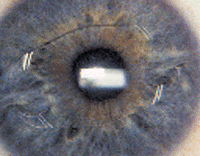 ---The Artisan Myopia Lens after implantation. Small folds of midperipheral iris tissue are captured in two haptics by which the lens is fixated. A peripheral iridectomy is performed to prevent pupillary block.
---The Artisan Myopia Lens after implantation. Small folds of midperipheral iris tissue are captured in two haptics by which the lens is fixated. A peripheral iridectomy is performed to prevent pupillary block.
J.G.F. Worst, MD, developed a claw-haptic lens for post-cataract aphakia two decades ago. Later a modified version of the lens for use in phakic patients was designed. The lens is manufactured by Ophtec bv in the Netherlands.
Dr. Worst said he recently simplified his implantation technique. The lens is inserted into the anterior chamber and fixated by pulling folds of iris into the claw haptics.
“We are at the close of an idea,” Dr. Worst said. “The Artisan lens works, but I haven’t been bothered much by the way to do it. It’s high time that I simplify the methods.”
For phakic implantation, Dr. Worst introduces a glide into the anterior chamber. The lens slides along this glide to ease implantation and to protect the iris. The technique is performed over an undilated pupil, which gives additional protection for the crystalline lens.
He inserts the glide and uses a cannula to bring the lens into a horizontal orientation. While holding the lens by its body, he pushes a fold of iris into the haptics to secure it.
“You have to keep in mind that you’re working on a very distended eye and you have limited space to work in,” Dr. Worst said. “You cannot compare it too easily with working on aphakia. It’s an approach in its own right.”
A significant modality
 ---Howard V. Gimbel, MD
---Howard V. Gimbel, MD
In Canada, Dr. Gimbel uses the STAAR (Monrovia, U.S.A.) Implantable Contact Lens (ICL) for refractive cases that cannot be treated for LASIK because of the high degree of correction required or a thin cornea.
He has used the sulcus-fixated lens in 50 eyes since 1997. The lens is made of a “collamer” material — a combination of collagen and synthetic polymer — that is thin and flexible. It is available in half-diopter steps up to 20 D. It is suspended by haptics over the crystalline lens in the posterior chamber.
The study protocol requires a YAG iridotomy before attempting implantation. Though not a contraindication, STAAR Surgical recommends that patients have an effective anterior chamber depth, or working space, of about 2.75 mm or greater, as measured from the posterior corneal surface to the anterior surface of the crystalline lens. Assuming an average corneal thickness of 0.55 mm, this would exclude the use of the ICL in eyes with an anterior chamber depth of less than about 3.25 mm, as traditionally measured from the anterior corneal surface to the crystalline lens.
The range of myopic correction in Dr. Gimbel’s patients was 6.5 D to 22 D. Hyperopes ranged up to 10 D. Higher hyperopes did not have deep enough anterior chambers to accommodate the lens, Dr. Gimbel said.
In Europe, the first STAAR Toric ICL was placed in a patient’s eye in Munich, Germany, marking the beginning of clinical trials.
In the United States, the lens is undergoing study under FDA protocols, said David C. Brown, MD, of Fort Myers, U.S.A.
The FDA has approved the expansion of the hyperopic ICL study to include patients with as little as 1.5 D of hyperopia, and to reduce the waiting period from 6 months to 45 days for patients to receive the ICL in the second eye.
STAAR investigators in the United States will implant 278 ICLs in patients and expand from 14 to 18 clinical sites. The expanded trials allow the enrollment of patients from 3 D to 20 D for the myopic and now from 1.5 D to 20 D for the U.S. hyperopic study.
Phase 1 to 2 U.S. studies of the ICL included 72 eyes. The average preoperative hyperopia was over 6 D, which placed most of the patients in a range too high to treat with photorefractive keratectomy (PRK). Two-thirds of the patients were within 0.5 D of emmetropia and 80% were within 1 D of emmetropia.
Uncorrected vision also improved; at the final available postoperative visit, more than 80% of patients were seeing 20/40 or better without correction.
In the United States, inclusion criteria for the ICL range from 7 D to 20 D of correction in patients with less than 2.5 D of cylinder. All patients are between 21 and 45 years of age and cannot have any history of cataract formation. Two YAG iridectomies are performed 90° apart. Corneal incisions are 4 mm or less, although most surgeons use a 3-mm incision and no sutures.
In the U.S. myopia study, 102 patients are far enough along to report data. Myopic patients averaged 10.2 D of correction, with a range of 6 D to 19 D, Dr. Brown said. The mean age is 37, with more females than males. Postoperative results showed that more than one-half of the patients achieved within 0.5 D of emmetropia.
“If you remember that most of these patients who we have been treating are of the higher degrees of the myopic spectrum, you can appreciate the wonderful predictability of the lens implant,” Dr. Brown said.
Patients with preop vision of between 20/400 and counting fingers achieved re mark able results, he added. The final best corrected visual acuity fell within one line of preoperative vision in 86 eyes. Another 13% increased two lines or more.
“Phakic IOLs will become a significant modality in refractive surgery,” Dr. Gimbel said. “The ICL shows great promise, but the disappointment is that some chambers are too shallow for the ICL. Hyperopes are the patients most likely to have anterior chamber depths that are too shallow.”
Safety compared
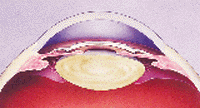 ---Cross-section of the convex-concave Artisan Myopia Lens.
---Cross-section of the convex-concave Artisan Myopia Lens.
Georges D. Baikoff, MD, developer of the NuVita lens, made by a Bausch & Lomb Surgical satellite company in Lyon, France, is naturally an advocate of anterior chamber phakic implants. He argues that there is not enough room in the posterior chamber for a phakic implant.
He said anterior chamber placement takes advantage of a large space, with fixation possible in the angle or the iris, with less risk to the crystalline lens or the uvea than in posterior chamber implantation.
Dr. Baikoff said his NuVita lenses are appropriate for patients with between 8 D and 25 D of myopia. He compared refractive results in patients implanted with a phakic IOL with those who underwent LASIK (see graphs). He studied two groups with either phakic IOLs or LASIK for 2 years. His LASIK group included 48 eyes and the phakic anterior chamber IOL group 80 eyes.
In the NuVita group, the uncorrected visual acuity average was 0.64, equal to about 20/32 Snellen visual acuity. The best corrected vision was 0.75 D, equal to about 20/25 Snellen acuity, and 73% of cases gained at least one line of visual acuity, Dr. Baikoff said.
LASIK patients required enhancements in 33% of cases, while phakic IOLs needed a lens exchange about 4% of the time for lens power or size.
Patients who received NuVita lenses generally performed better than LASIK patients in the first 6 months postop, he said. By 6 months, LASIK patients generally received enhancements, and then their results matched the NuVita lens group.
“The postop best corrected visual acuity is a little better with the NuVita group, but don’t forget that this NuVita group is higher myopes,” Dr. Baikoff said. “The best corrected visual acuity preoperatively is less than the LASIK group, but after surgery their visual acuity is better.”
Dr. Baikoff said that after 2 years follow-up he did not find any incidence of cataract, glaucoma, corneal edema or uveal detachment.
“The endothelial study is really good because after 1 week, there is 4% cell loss due to surgery and this cell loss is stable with time,” he said. “At the present time, we can tell that NuVita is safe to correct high myopia because there is no more endothelial damage ob served.”
Evolving design
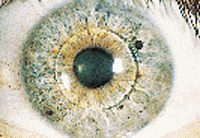 | 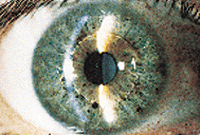 |
| A 42-year-old myope with a Phakic-6 in the left eye (left) and an ACN 60 in the right eye (right). The left eye was slightly undercorrected to allow for near function without glasses. The enhanced depth of focus that refractive implants create significantly reduces presbyopic requirements. | |
George Rozakis, MD, medical director of International Vision Inc. of Cincinnati, discussed the posterior chamber silicone Phakic Refractive Lens (PRL). His data includes results from implantation outside the United States of a Russian-made lens, although future manufacturing is planned for Irvine, U.S.A.
This lens is designed to float on a cushion of aqueous, and the formulation of silicone does not stick to the crystalline lens, Dr. Rozakis said. The Russian design has two lengths to choose from, both with an optic size of 4.5 mm. The lenses are molded instead of lathed, which allows them to be made with a narrow optic.
Complications included two cataracts in 600 cases that were most likely induced by surgery, Dr. Rozakis said. The low incidence rate probably results from the lens design, he said, which allows maximum aqueous delivery to the anterior crystalline lens.
Both cases of cataract occurred between 1 year and 16 months postoperatively. None of the patients at 5 years developed an anterior subcapsular cataract.
“I fully expect the incidence to drop as I train the surgeons to implant them,” Dr. Rozakis said. “We haven’t even developed our instruments yet.”
Decentration has been a problem, stemming from incorrect sizing of the implant. Decentration occurred when the overall length of the lens was 10.8 mm, and it dropped when the length was increased to 11.3 mm.
Treatment for decentration involves implant ex change. Also, surgeons are working on better measurements of the eye to determine the correct size beforehand.
“Clearly, decentration is a function of length of the optic,” Dr. Rozakis said. “We just don’t have enough information on the anatomy. So once we have the anatomy, we’ll simply evolve the design to fit the eye.”
While the Russian design had only two sizes, the American-made lens will expand that range.
Study to start
Dr. Galin started refractive anterior chamber implants in the 1970s, when he was researching intraocular telescopic lenses for patients with low vision.
After working with an early version of Dr. Baikoff’s lens, he approached Ophthalmic Innovations International to develop a thinner lens with a larger optical zone.
Design modifications resulted in the Phakic 6, a single-piece, heparin-coated PMMA lens. The lens is very compressible, offering almost no resistance. Compressing the lens 1 mm in the anterior chamber causes it to vault only 0.1 mm forward. The plus lenses have the same edge thickness, regardless of dioptric power. Minus lenses have variable edge thickness. A minus 15 diopter lens, for example, has an edge thickness of only 0.5 mm.
Ophthalmic Innovations makes lenses for both myopia and hyperopia. They are available in Europe, South America and Mexico.
“Any one of these refractive IOLs is superior to corneal procedures such as RK [radial keratotomy], PRK and LASIK,” Dr. Galin said. “Even the best laser surgeon will tell you an implant has better optics. The question is, will it be as safe?”
For Your Information:
- Georges D. Baikoff, MD, practices at Clinique Monticelli, 88 Rue Du Commandant Rolland, Marseille 13008 France; +(33) 4-911-62228; fax: +(33) 4-911-62225. Dr. Baikoff has a direct financial interest in the Nuvita lens. He is a paid consultant of Bausch & Lomb.
- David C. Brown, MD, practices at 4101 Evans Ave., Ft. Myers, FL 33901-9310 U.S.A.; +(1) 941-939-3456; fax: +(1) 941-936-8776. Dr. Brown has no direct financial interest in any of the products mentioned in this article. He is a paid consultant for STAAR Surgical.
- Miles A. Galin, MD, can be reached at East Side Ophthalmology, PC, 345 E. 37th St., Ste. 301, New York, NY 10016 U.S.A.; +(1) 212-922-1400; fax: +(1) 212-922-1423. Dr. Galin has no direct financial interest in any of the products mentioned in this article. He is a paid consultant for Ophthalmic Innovations International.
- Howard V. Gimbel, MD, practices at the Gimbel Eye Center, 4935 40th Ave. NW, Ste. 450, Calgary, Alberta, T3A 2N1, Canada; +(1) 403-286-3022; fax: +(1) 403-286-2943. Dr. Gimbel has no direct financial interest in any of the products mentioned in this article, nor is he a paid consultant for any companies mentioned.
- George Rozakis, MD, can be reached at the Northeastern Eye Center, 25730 Lorain Road, North Olmstead, OH 44070-3326 U.S.A.; +(1) 440-777-2667; fax: +(1) 440-777-2682. Dr. Rozakis has a direct financial interest in the PRL. He is medical director of IVI Medennium Inc.
- J.G.F. Worst, MD, can be reached at Julianalaan 11, Haren (GN) 9751 BM, Amsterdam, Holland, The Netherlands; +(31) 50-534-8320; fax: +(31) 50-534-9877. Dr. Worst has a direct financial interest in the Artisan phakic IOL. He is not a paid consultant for any companies mentioned.
- Bausch & Lomb Surgical can be reached at 555 W. Arrow Highway, Claremont, CA 91711 U.S.A.; (800) 423-1871; fax: +(1) 909-399-1525.
- Ophtec bv can be reached at Schweitzerlaan 15, 9728 N Groningen, The Netherlands; +(31) 50-5251944; fax: +(31) 50-5254386.
- Ophthalmic Innovations International can be reached at 550 N. Claremont Blvd., Claremont, CA 91711 U.S.A.; +(1) 909-626-4558; fax:+(1) 909-626-7338.
- STAAR Surgical Co. can be reached at 1911 Walker Ave., Monrovia, CA 91016 U.S.A.; +(1) 626-303-7902; fax: +(1) 626-359-8402.
- IVI Medennium Inc. can be reached at 15350 Barrance Parkway, Irvine, CA 92618 U.S.A.; +(1) 949-789-5300.
NuVita vs. LASIK | |
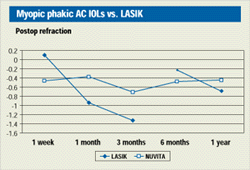 |  |
 | 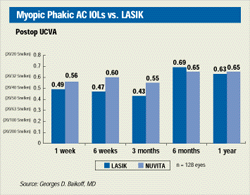 |
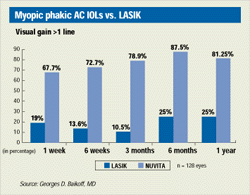 | 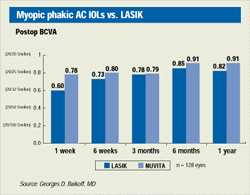 |
STAAR ICL Study | |
 |  |
